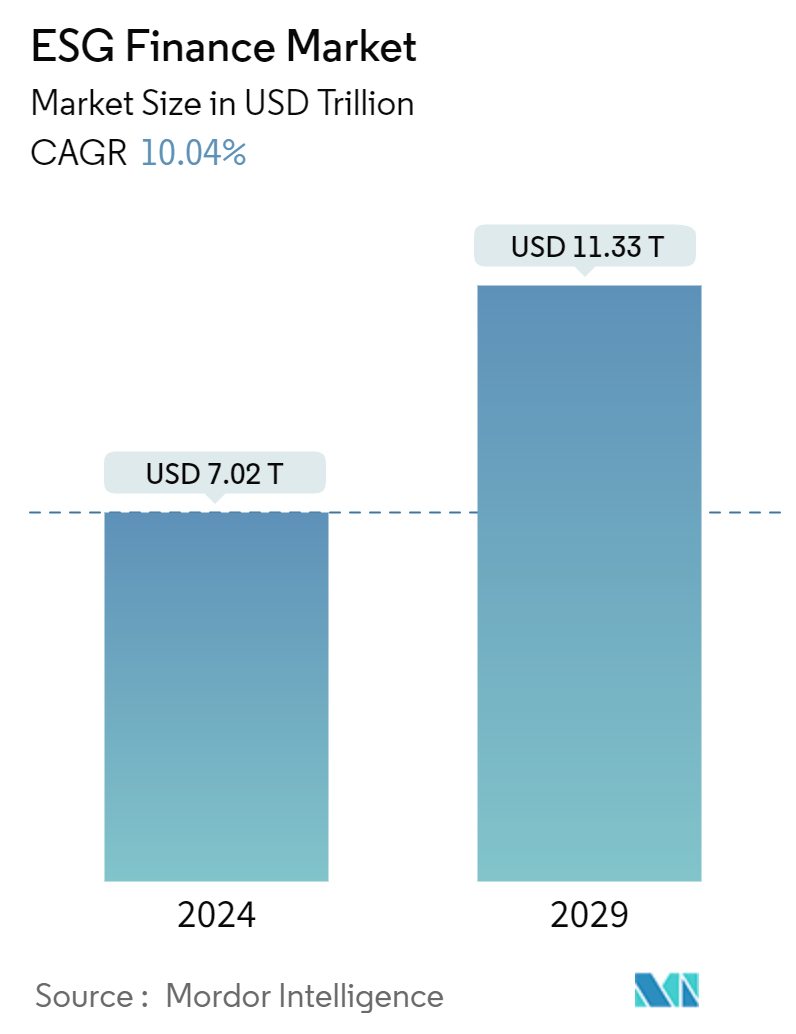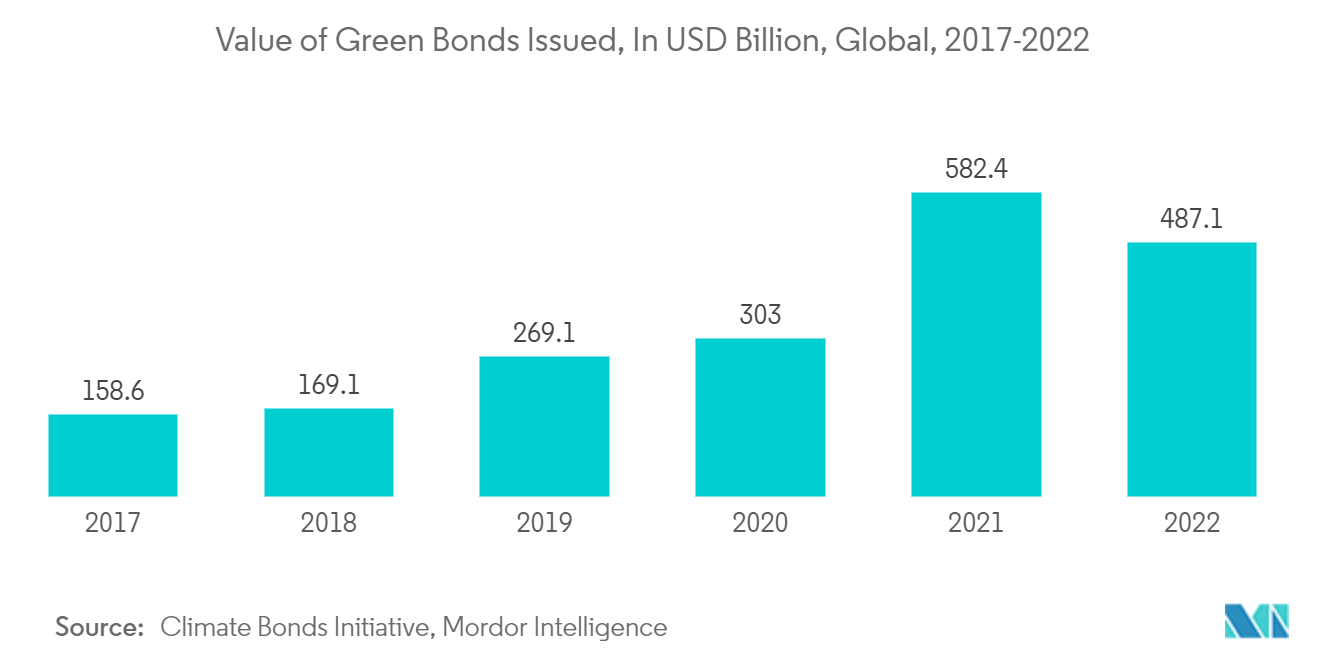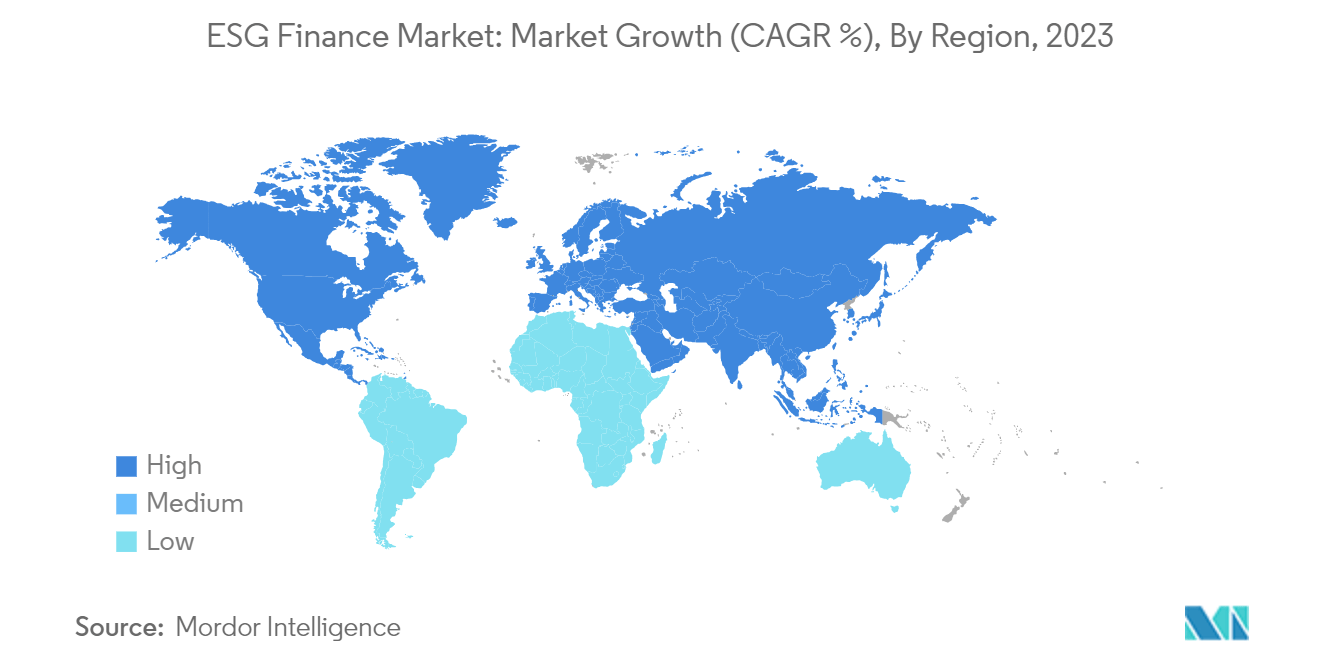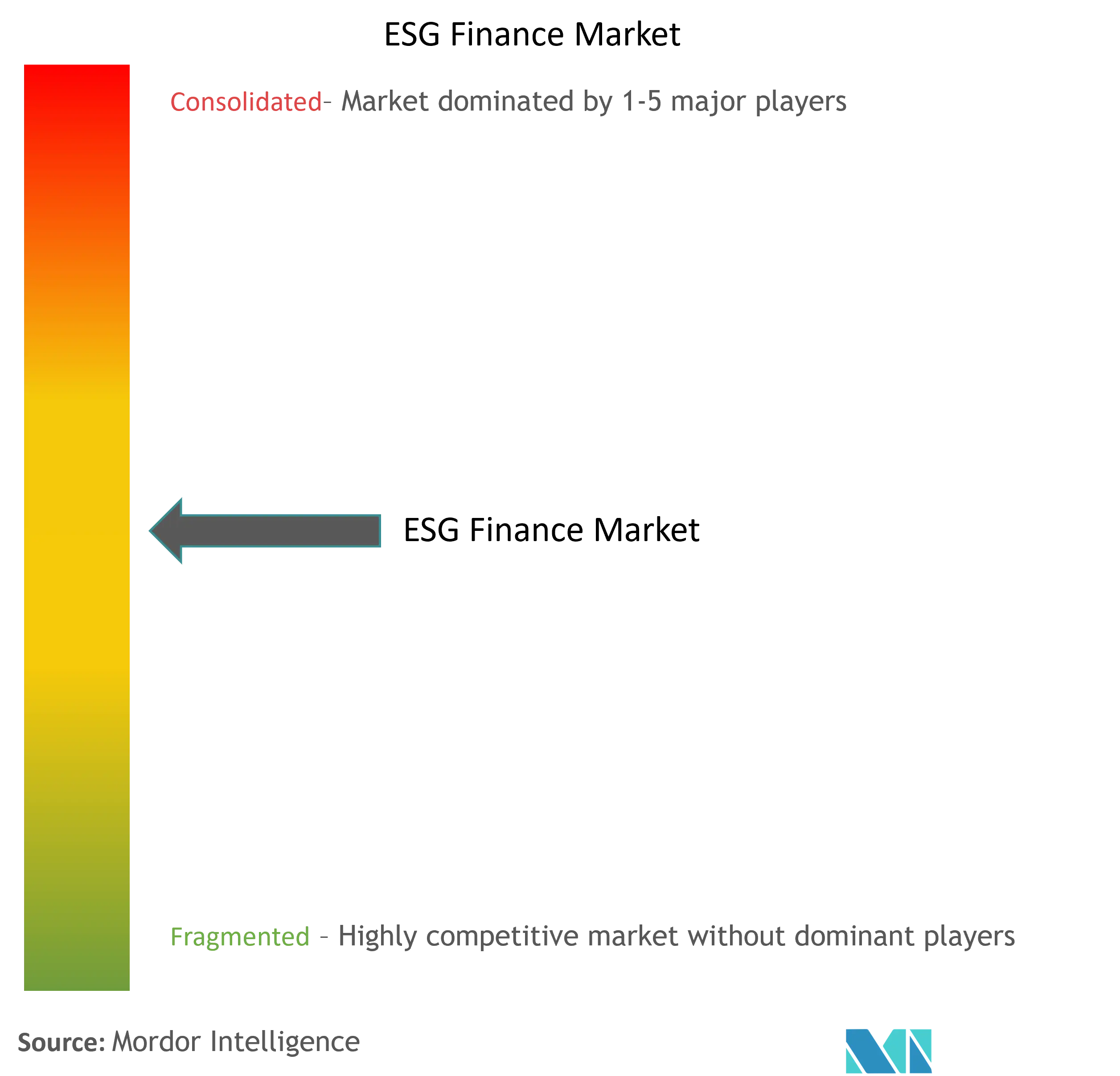ESG Finance Market Size

| Study Period | 2020 - 2029 |
| Market Size (2024) | USD 7.02 Trillion |
| Market Size (2029) | USD 11.33 Trillion |
| CAGR (2024 - 2029) | 10.04 % |
| Fastest Growing Market | North America |
| Largest Market | Europe |
Major Players
*Disclaimer: Major Players sorted in no particular order |
ESG Finance Market Analysis
The ESG Finance Market size is estimated at USD 7.02 trillion in 2024, and is expected to reach USD 11.33 trillion by 2029, growing at a CAGR of 10.04% during the forecast period (2024-2029).
Investment in sustainable firms is rising due to the increasing demand for financial professionals specializing in sustainable finance. Not only does sustainable finance reduce risk exposure and improve returns, but it also reduces costs and mitigates risk. However, market growth is limited by challenging diversification challenges and high operating expenses. Despite this, the market for sustainable finance has a lot of potential for profitability as industries become more conscious of the environment.
The ESG finance market is growing due to an increase in investment in sustainable businesses. Investors increasingly know the need to tackle environmental and social issues and are looking for sustainable investment opportunities.
The market is expected to grow as people become more aware and concerned about the environment and social problems, including climate change, depletion of resources, and social injustice. This increased awareness has led to an increase in the need for sustainable financial solutions as people, companies, and institutions want to make sure their investments are in line with their beliefs and help make the world a better place. Regulatory frameworks and government policies also play an important role in the market's growth.
Sustainable finance comes in many forms. Institutional investors and funds are now embracing a variety of ESG investing strategies. This shift has been driven by changes in demand across the financial system, driven by both a desire for better long-term financial value and a desire to align with values. For instance, one of the most notable developments in ESG finance in the current year is the phenomenal growth of green issuance, compared to significant declines in issuance in the United States and Asia.
ESG Finance Market Trends
Rising Investments in Green Bonds
Green bond transactions have gained the most market share in the sustainability finance market. There is a growing awareness and urgency around environmental issues, including climate change and sustainability. Investors and institutions are looking for investment opportunities that are in line with their environmental goals.
Green bonds provide issuers with a clear and straightforward route to raising capital for projects that have a positive impact on the environment. These projects are typically focused on renewable energy, improving energy efficiency, and clean transportation, among other projects for greenhouse gas (GHG) emissions reductions and support sustainable development. Third, investors are increasingly prioritizing sustainable investments. As a result, there is a surge in demand for green bonds, driving the market’s growth.
Green bond transactions have captured the largest share of the global sustainable finance market due to the increasing awareness of environmental issues among investors and the support of regulatory measures. As the demand for sustainable investments increases, green bonds will continue to play an important and effective role in funding socially responsible projects to combat environmental issues.

Europe is Dominating the ESG Finance Market
The European sustainable finance market accounts for a significant revenue share. The market will continue to grow in Europe due to strong government and regulatory support for sustainable initiatives, growing investor demand for responsible investment, and the region’s focus on environmental and climate objectives. For example, the European Union’s Sustainable Finance Action Plan seeks to redirect capital flows towards sustainable projects and bring financial markets in line with sustainability objectives. The EU’s Taxonomy Regulation also provides a standardized framework to classify sustainable economic activities, increasing transparency and credibility in Europe’s sustainable finance practices.
In addition, one of the reasons for Europe’s market dominance is the increasing adoption of sustainability fintech. Sustainable fintech platforms allow people and businesses to make ethical investment choices by incorporating ESG factors into financial products and services.

ESG Finance Industry Overview
The ESG Finance Market is moderately fragmented. The key players often merge, form strategic partnerships, and collaborate to increase their market share and expand their services. With a strong emphasis on sustainability and responsible investing, these companies aim to capture a large share of the market and become leaders in sustainable finance. As the need for sustainable finance increases, these companies will continue to dominate the market and play an important role in the future of global sustainable finance. Some of the leading players in global sustainable finance include BlackRock, Inc., State Street Corporation, Morgan Stanley, UBS, and JPMorgan Chase & Co.
ESG Finance Market Leaders
-
BlackRock, Inc.
-
State Street Corporation
-
Morgan Stanley
-
UBS
-
JPMorgan Chase & Co.
*Disclaimer: Major Players sorted in no particular order

ESG Finance Market News
- In February 2024, State Street Corporation acquired CF Global Trading. CF Global Trading is a global provider of agency-based trading services for a wide range of asset classes, including stocks, listed derivatives, and fixed-income instruments. Terms of the transaction were not disclosed.
- In January 2024, BlackRock, Inc., the world’s largest alternative asset manager, and Global Infrastructure Partners, the largest independent infrastructure fund manager in the world, announced that they entered into an agreement whereby BlackRock will acquire GIP for a total of USD 3 billion in cash and approximately 12 million BlackRock common shares.
- In October 2023, Morgan Stanley Investment Management (MSIM), through its private infrastructure investment platforms, MSIP, completed the acquisition of Sacyr S.A. through its investment funds. Sacyr is commonly referred to as "Valoriza" or the "Company."
ESG Finance Market Report - Table of Contents
1. INTRODUCTION
- 1.1 Study Assumptions and Market Definition
- 1.2 Scope of the Study
2. RESEARCH METHODOLOGY
3. EXECUTIVE SUMMARY
4. MARKET DYNAMICS
- 4.1 Market Overview
-
4.2 Market Drivers
- 4.2.1 Rise in Investment in Businesses with Sustainable Practices is a Driving Force Behind the Growth of The Sustainable Finance Market
- 4.2.2 Increasing Government Initiative Towards Sustainability
-
4.3 Market Restraints
- 4.3.1 Lack of Agreement on ESG Data and The Availability of These Data Points.
- 4.3.2 Mobilization and Incentivisation of Private Companies, Especially Small to Medium Enterprises, to Share Their ESG Data.
-
4.4 Market Opportunities
- 4.4.1 Non-profit Organisations and Academic Institutions are Also Vital in Driving Awareness of Sustainable Finance.
- 4.4.2 The Promotion of Environmental and Social Consciousness and Consumerism Among People and Investors.
- 4.5 Value Chain / Supply Chain Analysis
-
4.6 Porters 5 Force Analysis
- 4.6.1 Threat of New Entrants
- 4.6.2 Bargaining Power of Buyers/Consumers
- 4.6.3 Bargaining Power of Suppliers
- 4.6.4 Threat of Substitute Products
- 4.6.5 Intensity of Competitive Rivalry
- 4.7 PESTLE Analysis
5. MARKET SEGMENTATION
-
5.1 By Investment Type
- 5.1.1 Equity, Fixed Income, Mixed Allocation
- 5.1.2 Fixed Income
- 5.1.3 Mixed Allocation
- 5.1.4 Other Investment Types
-
5.2 By Transaction Type
- 5.2.1 Green Bond
- 5.2.2 Social Bond
- 5.2.3 Mixed Sustainability Bond
- 5.2.4 ESG Integrated Investment Funds
- 5.2.5 Other Transaction Types
-
5.3 By Investor Type
- 5.3.1 Institutional Investors
- 5.3.2 Retail Investors
-
5.4 By Industry Vertical
- 5.4.1 Utilities
- 5.4.2 Transport & Logistics
- 5.4.3 Chemicals
- 5.4.4 Food and Beverage
- 5.4.5 Government
- 5.4.6 Other Industry Verticals
- 5.5 By Region
-
5.6 North America
- 5.6.1 United States
- 5.6.2 Canada
- 5.6.3 Mexico
- 5.6.4 Rest of North America
-
5.7 Europe
- 5.7.1 United Kingdom
- 5.7.2 Germany
- 5.7.3 France
- 5.7.4 Russia
- 5.7.5 Italy
- 5.7.6 Spain
- 5.7.7 Rest of Europe
-
5.8 Asia-Pacific
- 5.8.1 India
- 5.8.2 China
- 5.8.3 Japan
- 5.8.4 Australia
- 5.8.5 Rest of Asia-Pacific
-
5.9 South America
- 5.9.1 Brazil
- 5.9.2 Argentina
- 5.9.3 Rest of South America
-
5.10 Middle-East and Africa
- 5.10.1 United Arab Emirates
- 5.10.2 South Africa
- 5.10.3 Rest of Middle-East and Africa
6. COMPETITIVE LANDSCAPE
- 6.1 Vendor Market Share
- 6.2 Mergers & Acquisitions
-
6.3 Company Profiles
- 6.3.1 BlackRock, Inc.
- 6.3.2 State Street Corporation
- 6.3.3 Morgan Stanley
- 6.3.4 UBS
- 6.3.5 JPMorgan Chase & Co.
- 6.3.6 Franklin Templeton Investments
- 6.3.7 Amundi US
- 6.3.8 The Bank of New York Mellon Corporation
- 6.3.9 Deutsche Bank AG
- 6.3.10 Goldman Sachs*
- *List Not Exhaustive
7. MARKET OPPORTUNITIES AND FUTURE TRENDS
8. DISCLAIMER AND ABOUT US
** Subject To AvailablityESG Finance Industry Segmentation
The ESG finance market is segmented by investment type, transaction type, investor type, industry vertical, and region. By investment type, the market is segmented into equity, fixed income, mixed allocation, and others. By transaction type, the market is segmented into green bonds, social bonds, mixed sustainability bonds, ESG-integrated investment funds, and others. By investor type, the market is segmented into institutional investors and retail investors. By industry vertical, the market is utilities, transport & logistics, chemicals, food and beverage, government, and others, and by region, the market is segmented into North America, Latin America, Europe, Asia-Pacific, Middle East and Africa. The report offers market size and forecasts for the ESG finance market in value (USD) for all the above segments.
| By Investment Type | Equity, Fixed Income, Mixed Allocation |
| Fixed Income | |
| Mixed Allocation | |
| Other Investment Types | |
| By Transaction Type | Green Bond |
| Social Bond | |
| Mixed Sustainability Bond | |
| ESG Integrated Investment Funds | |
| Other Transaction Types | |
| By Investor Type | Institutional Investors |
| Retail Investors | |
| By Industry Vertical | Utilities |
| Transport & Logistics | |
| Chemicals | |
| Food and Beverage | |
| Government | |
| Other Industry Verticals | |
| North America | United States |
| Canada | |
| Mexico | |
| Rest of North America | |
| Europe | United Kingdom |
| Germany | |
| France | |
| Russia | |
| Italy | |
| Spain | |
| Rest of Europe | |
| Asia-Pacific | India |
| China | |
| Japan | |
| Australia | |
| Rest of Asia-Pacific | |
| South America | Brazil |
| Argentina | |
| Rest of South America | |
| Middle-East and Africa | United Arab Emirates |
| South Africa | |
| Rest of Middle-East and Africa |
ESG Finance Market Research FAQs
How big is the ESG Finance Market?
The ESG Finance Market size is expected to reach USD 7.02 trillion in 2024 and grow at a CAGR of 10.04% to reach USD 11.33 trillion by 2029.
What is the current ESG Finance Market size?
In 2024, the ESG Finance Market size is expected to reach USD 7.02 trillion.
Who are the key players in ESG Finance Market?
BlackRock, Inc., State Street Corporation, Morgan Stanley, UBS and JPMorgan Chase & Co. are the major companies operating in the ESG Finance Market.
Which is the fastest growing region in ESG Finance Market?
North America is estimated to grow at the highest CAGR over the forecast period (2024-2029).
Which region has the biggest share in ESG Finance Market?
In 2024, the Europe accounts for the largest market share in ESG Finance Market.
What years does this ESG Finance Market cover, and what was the market size in 2023?
In 2023, the ESG Finance Market size was estimated at USD 6.32 trillion. The report covers the ESG Finance Market historical market size for years: 2020, 2021, 2022 and 2023. The report also forecasts the ESG Finance Market size for years: 2024, 2025, 2026, 2027, 2028 and 2029.
ESG Finance Industry Report
Statistics for the 2024 ESG Finance market share, size and revenue growth rate, created by Mordor Intelligence™ Industry Reports. ESG Finance analysis includes a market forecast outlook for 2024 to 2029 and historical overview. Get a sample of this industry analysis as a free report PDF download.



